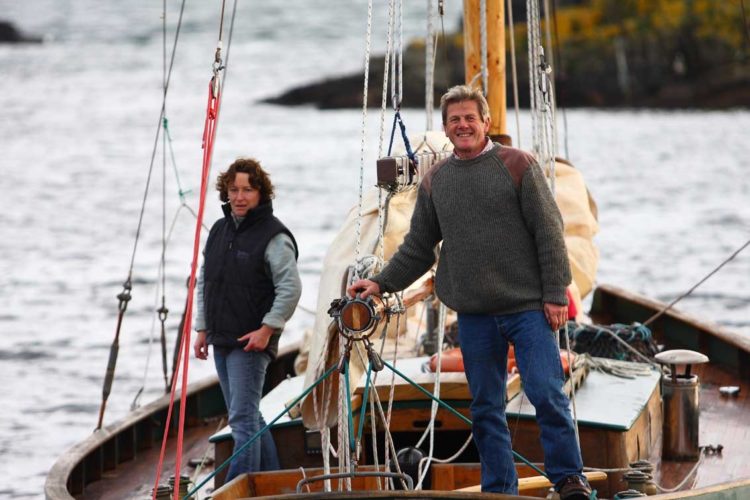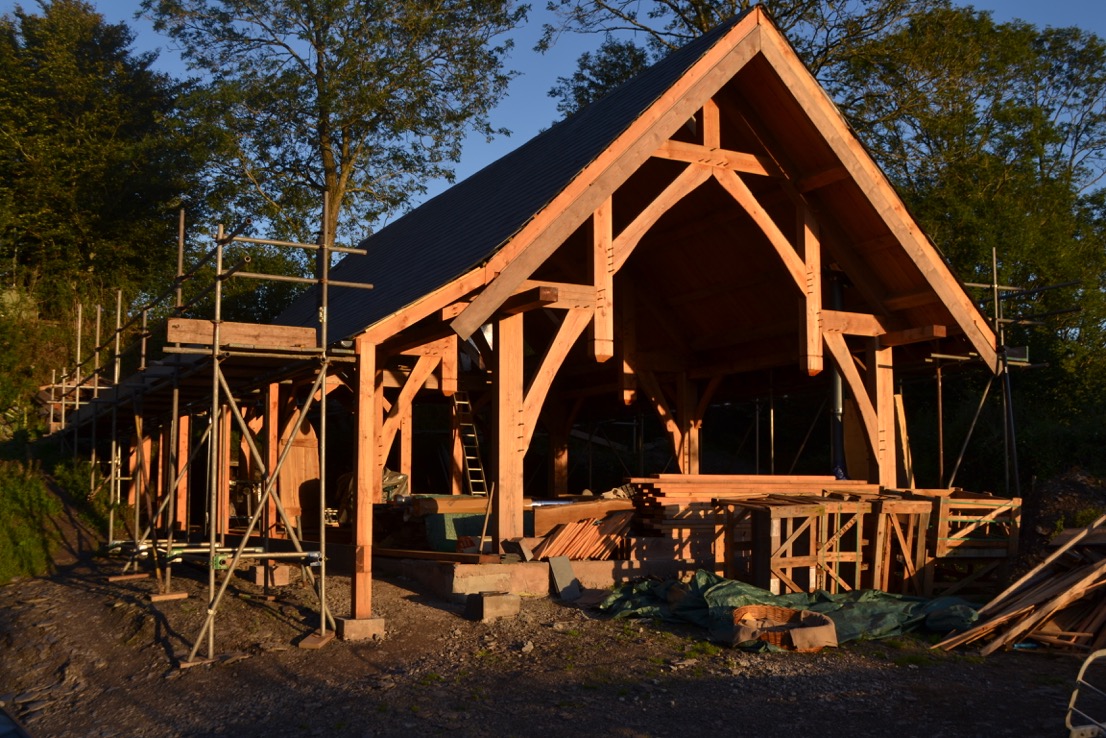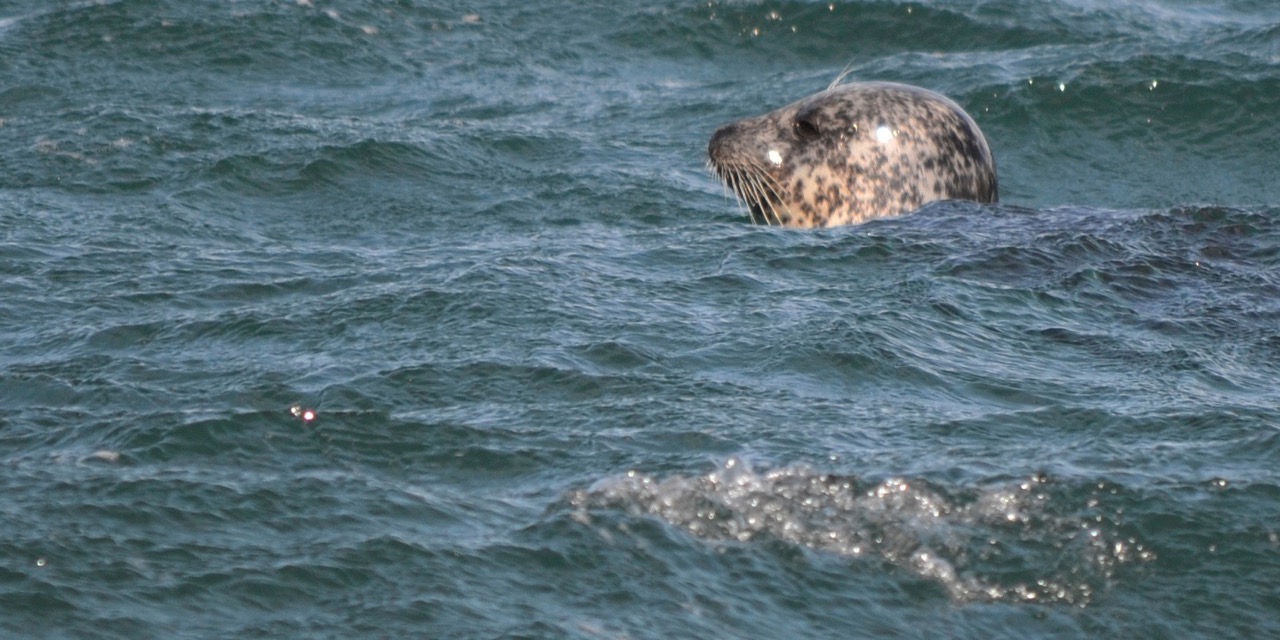
At first glance, remote power specialist Victron Energy’s offer to host a series of blogs from me – that knows nothing about electronics – seems like commercial suicide.
We’re building a Straw Bale house which has a medieval-style frame – the sort where the timber joints are held together not by glue, but by wooden pegs. The 600 year-old technology used in pegged-joint timber-framing is right up my street. Our house-build is taking place within the Exmoor National Park, in the United Kingdom, and its rural location is one of the reasons we’ve decided not to connect to the National Electricity Grid. So I wondered if a blog about our amateur installation of a cutting-edge off-grid power system into a medieval-styled house might not go amiss?
Medieval Frame
As a prelude to this series of blogs, a bit of background about Linda, my wife, and I might be helpful:
We used to live on a 15 ton wooden sailing boat which we built ourselves – starting with the trees. We’re not trained as boatbuilders – it was just one of those mad ideas you wake up with one morning. The boat build should have gone badly wrong …but it didn’t. During the 2 years and 9 months it took to build our boat part of me never really believed it would float …or at least, not the right-way-up.
Our Boat
We lived on board for seven years, sailing between the Celtic coasts of France, Ireland, Cornwall and Scotland – choosing to stay in remote sea lochs amid stunning wilderness landscapes; just us, the deer and the birds of prey. Being some distance from civilization taught us that what we consumed (water, electricity, food, firewood) had to be replaced, and in some places it might take up to three days to get to a tap, or to the shops, and drop anchor again back in our chosen spot. So we fell into the habit of minimising waste; and making decisions about whether our use of something was really necessary – without causing ourselves misery or hardship, of course …after all we’re only human.
Taking responsibility for what we consumed wasn’t as tedious as we imagined it might be, and we discovered what many people already know – less is often more. Not only that but we saved an extraordinary amount of money by cutting down on waste, which meant we didn’t have to work so hard, and so could spend more time roaming around. As Benjamin Franklin [American Statesman] said: Few people realise what income there is in economy.
I’ll be honest, one of the things we were looking forward to when we lived in a house again was ‘real’ electricity …at the flick of a switch. But when the electricity board explained that a connection to the grid, underground, through a field we don’t own would cost around £7,000 – followed of course by monthly bills, we decided that we had sufficient experience of ‘sustainable’ living to spend the money instead on generating our own Photo-voltaic based electricity.
I’m not at all ashamed of my lack of knowledge of electronics – I put it down instead to a long standing medical-condition which, funnily enough, my Physics tutor diagnosed back in my school days. The class was discussing Faraday, Ohms law and how many volts you got if you stuck an iron rod into a jar of Pineapple juice whilst I dreamily busied myself by making a dead short between the positive and negative terminals of a traction battery on the bench in front of me using the metal clip of my fountain pen …to see if anything would happen. As I fiddled I was sure I heard Mr. McCloud, our tutor, pose a question to the class which I could answer – and found as I raised my hand that I alone could answer it. Seeing that mine was the only hand he reluctantly picked me, and my answer, when I had delivered it, was followed by a long silence. Mr. McCloud fixed his eyes on me and leant heavily against his desk using both arms for support, his head hanging low between them like a Galapagos tortoise. That’s when he made his contribution to Medical Science …as soon as he had regained the power of speech he gave me my diagnosis:
Tyers, he said; you are a congenital idiot.
And at that moment my pen burst into flames.
What I am ashamed of is that I’m not very ‘green’. Whenever I hear of someone building themselves a Straw Bale house part of me dies. I imagine they must be eco-warriors, born to save the planet. The very last thing I thought was that one day I would build one. But our reasons for building a house from straw, and our reasons for going ‘off-grid’ are the same – we want to take back control …of our bills.
We’re none of us getting any younger – as my Gran said just before she died – and the treadmill I’m on …working by day to pay bills at night seems if anything to be speeding up, whilst at the same time my stamina to keep treading is in decline. So we’ve decided to step off …do the full Monty: Private water supply, Private sewerage; Hot Water fired by the fallen wood we pick up on our country walks (surreptitiously assisted by our chain saw); and our own Electricity from photo-voltaic panels.
We’re building our house near Hinkley Point – the Nuclear Power Station which has just received permission to construct a new reactor. If I remember correctly the Government has agreed to buy electricity from Hinkley for 50p per unit when it’s operational – in 12 or so years’ time. That’s nearly 4 x today’s cost-per-unit. So there’s a hint – if ever I heard one – that energy will soon be much more expensive. Imagine, with our Goblin Whisper vacuum cleaner consuming 1400 Watts, it’ll cost us 75 pence every time we want to clean the house! Which admittedly isn’t very often.
This evening – right now, I mean – I’m writing these words on a lap-top …there are five hours remaining on the battery. When it needs recharging, or if I want to access the internet at any time, I have to start our 5kVA diesel generator. And during these long winter’s nights when Linda cooks our supper, she cooks – and we eat – by candle light. We’re usually in bed by 8:30, then we read for a couple of hours using head torches. So we’re quite looking forward to having electricity.
We haven’t chosen any of the electronic kit which will provide our house with 240 AC electricity except for the 15 Photovoltaic panels which I installed on the roof a couple of months ago. If I was to go in the house right now I’d see their wires dangling idly down, waiting to provide us with 3900 watts of oomph.
Because I’m a novice I’m not even sure how many cups of tea I’ll get for my 3900 watts – and of course I’m afraid of making a mistake with the components I choose for our off-grid system …buying the wrong gauge wires, wasting precious money on stuff I don’t need, or buying stuff that is just ‘wrong’ for my circumstance.
Whilst researching off-grid systems a number of people recommended Victron Energy kit for its quality. It’s time to discover, using the tools and assistance available from Victron’s website and employees and agents, how easy or hard it is for the lay-man (who has no interest in becoming an expert) to choose the appropriate equipment for his or her own lifestyle.
Step one when designing your off-grid system everybody tells me, is to make an inventory of your electricity-consuming appliances, work out how many hours-per-day they’re in-use, and from that information derive your daily electricity requirement. Of course, some appliances don’t get used every day – our Breville sandwich toaster, for example, didn’t come out of its box until the guarantee had run out, and when I opened it I found a toasted sandwich in it – so I must have used it at some stage. Unless it was an ex-demonstration model.
But I thought it might be wise to calculate our electricity requirement for one of those busy spring-cleaning sort of days when all is right with the world and the dust seems to get blown off every appliance you own.
If we install a system which can look after us through the madness of a top-to-bottom spring clean of the house and its occupants, then we won’t be forever running to the controls to see how much power we’ve got left on our couch-potato days.
| Appliance | Power W | Daily energy Wh | Comments |
| Fridge / Freezer | 33 | 800 | |
| Microwave | 800 | 66 | |
| Kenwood Chef | 600 | 100 | |
| Healthy-Living Vegetable Juicer 1200W | 0 | 0 | Annual consumption, also nil. |
| Deep Fat Fryer | 1200 | 10GW | Gigawatts. |
| Washing Machine | 2000 | 500 | Every few days. |
| Dishwasher | 2000 | 1000 | Every other day. |
| Computer | 150 | 1200 | |
| Lighting | 150 | 450 | All LED. |
| UV water treatment | 40 | 480 | I know, you’re meant to leave them on all day. |
| Water Pump | 1100 | 100 | |
| Immersion Heater | 3000 | 0 | Summer use, only as an excess solar power dump. |
| Iron | 1000 | 250 | |
| ‘Hoover’ | 1400 | 1400 | |
| Hi fi | 60 | 120 | |
| Wi fi Broadband Router | 8 | 192 | 24/7 for data logging? |
| Kettle | 3000 | 0 | Emergency use if we run out of gas and the wood-burning range isn’t alight. |
| Hair Dryer | 1500 | 150 | |
| Total | 6818 Wh daily |
After living on the boat we lived on a Hebridean Island for eight years. No one comes to read your electricity meter if you live on a Hebridean Island – it’s not worth the rough ferry crossing just to read meters in a handful of houses. What the Scottish energy providers do instead is quite clever: They post you an ‘Estimated’ bill which is so exorbitant that as soon as you open the envelope you faint clean-away on your doorstep …once you’ve been ‘brought round’ with smelling salts and have been helped back to your feet you run – yes run! – to the meter cupboard to read the meter for them. At length you become familiar with your power usage …ours, I noticed, as I shone a torch through the cobwebs was about 16.5 kWh/day.
My inventory (above) for our projected off-grid usage is less than half the energy we know we used last time we lived in a house – surely the inventory is wrong?
Partly the difference is explained by the fact that in the Hebrides we were ‘all electric’ …and although we made fairly stingy use of our storage heaters, we used a ceramic hob to fry our chops, an electric oven to bake plump loaves, and boiled an electric kettle to make my 20 cups of tea each day …and when we bathed in our freezing cold blockhouse bathroom we bathed in water which was heated electrically. And another thing, in the south of the United Kingdom dark winter’s nights begin around 5 in the afternoon and end shortly after 7 the following morning; in the Hebrides night-time begins in late October and ends in March.
Over the next week or two I shall be choosing and ordering the components for our off grid system – then I’ll write again to tell you what we’ve got …how we’re getting on with wiring it all up …and all the interesting discoveries we’re making as we prepare to power our house from the sun.
Now it’s turned colder we’re sleeping in the workshop where we’ve installed a wood-burning stove which is throwing a cheerful red glow over the dog, lying at me feet. On the table a solitary candle burns bright. Linda has just put down her book and turned her head torch off …it must be time for bed.
If you’re considering installing your own system, follow our journey. And please leave a comment …or advice …or get in touch just to let me know whereabouts in the world you are. I like knowing where people are.
P.S. I meant to tell you – I do have a plan B …if it all goes belly-up we’re going to cut niches in our medieval frame to support torches which we’ll make from old rags dipped in tallow.
Justin Tyers


















